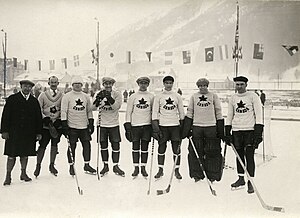 The Toronto Granites, representing Canada, won the gold medal | |
| Tournament details | |
|---|---|
| Host country | |
| Venue(s) | Stade Olympique de Chamonix (outdoors) |
| Dates | January 28 – February 3, 1924 |
| Teams | 8 |
| Final positions | |
| Champions | |
| Runner-up | |
| Third place | |
| Fourth place | |
| Tournament statistics | |
| Games played | 16 |
| Goals scored | 310 (19.38 per game) |
| Scoring leader(s) | |
The men's ice hockey tournament at the 1924 Winter Olympics in Chamonix, France, was the second Olympic Championship, also serving as the second World Championships. The competition was held from Monday, January 28, 1924, to Sunday, February 3, 1924. Canada, represented by the Toronto Granites, defended its championship from the 1920 Summer Olympics. The United States and Great Britain took the silver and bronze respectively, while other contenders included Czechoslovakia, France, and Sweden.[1]
The Bergvall system used in the 1920 Olympics was discarded in favor of a two-level round-robin tournament. Qualifying teams were placed in pools for the opening round, with the top two teams in each pool advancing to the final round. The medals were awarded based on the record in the final round. This format would remain in use until the 1992 Winter Olympics, when the final round-robin was replaced with a medal-round single-elimination tournament.
The Canadian Amateur Hockey Association (CAHA) chose the Toronto Granites as the 1923 Allan Cup champions to represent Canada, and W. A. Hewitt was chosen oversee the national team's finances at the Olympics.[2][3] Hewitt was empowered by the CAHA to name replacement players as needed,[4] and recruited Harold McMunn and Cyril Slater as replacements when four players from the Granites were unable to travel to the Olympics.[5] In his weekly report to the Toronto Daily Star, Hewitt wrote that the Granites would face multiple changes in conditions compared to hockey games in Canada. He did not feel the team would be affected by playing outdoors on natural ice in the morning or afternoon, despite that the team was accustomed to playing indoors with electric lighting on artificial ice. He also felt that the larger ice surface and lack of boards around the sides of the rink would mean more stick handling and less physical play.[6]
Austria was eligible to compete after having been excluded in 1920, but they withdrew just before the tournament due to the ineligibility of three international players.[7]
- ^ "Ice Hockey at the 1924 Chamonix Winter Games". Sports Reference. Archived from the original on 17 April 2020. Retrieved 10 May 2019.
- ^ "J. H. Crocker Is Olympic Head". The Winnipeg Tribune. Winnipeg, Manitoba. 24 October 1923. p. 13.

- ^ "Billy Hewitt Again In Charge of Hockey Team; Granites Sail January 11". The Brandon Sun. Brandon, Manitoba. 17 October 1923. p. 4.

- ^ "Bar Commercial Teams From Race For Allan Cup". Lethbridge Herald. Lethbridge, Alberta. 5 December 1923. p. 6.

- ^ Rodden, Mike (13 September 1966). "Sports Highways". The Kingston Whig-Standard. Kingston, Ontario. p. 9.

- ^ "Canadian Team Find Change In Match Conditions". Brandon Daily Sun. Brandon, Manitoba. 22 January 1924. p. 4.

- ^ "Eishockey". ANNO. Retrieved 10 February 2023.